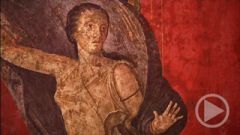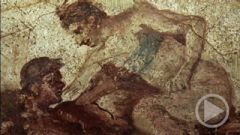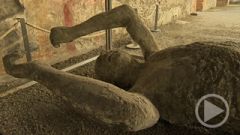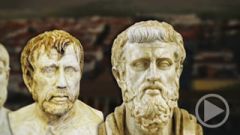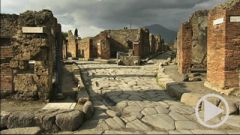From Bakeries to Vineries: Work
From Bakeries to Vineries: Work
Nearly half the inhabitants of Pompeii are believed to have been slaves. They were generally freed at around 30 years of age, and many of them went on to start up businesses as tradesmen or shopkeepers. Here in the Macellum, slaves would have purchased from slaves, some taking care of their owners‘ households, the others selling the fruits of their own labour. This largest market in the city mainly dealt in meat and fish, as shown by the many bones found in excavations.
More than 50 professions have been identified in Pompeii, ranging from weavers to barbers, from painters to ”Public Pig Keeper“. Among the most important tradesmen are the bakers. Pompeii has more than three dozen bakeries. This is where the flour is freshly ground. The mills are turned by donkeys or mules. A side room off the bakery is the stall for these four-legged Pompeians. The heart of the bakery is the oven. More than a thousand years later this kind of wood-burning oven will produce the first pizza.

Woolmaking is a flourishing branch of the economy. This laundry is located directly on the main street. Here the raw wool gets washed – as does completed clothing. The detergent used for washing the wool is urine. Its high levels of ammonia are good for dissolving fat. Slaves stand up to their ankles in the urine brine “walking” the wool with their feet. That is followed by several rinses until the fabrics can be hung out on the roof to dry. The laundry belongs to a certain Stephanus – on the façade he is advertising himself for the upcoming elections.
This store sign made of marble shows activities in a metal workshop. First the raw material has to be weighed – even if the small son of the owner is getting in the way. On an anvil the smith is making bowls, kettles and pails. They wouldn’t sell without some adornment – that’s being taken care of by a talented artisan. This workshop also has a dog – he enjoys an overview of the workshop from a ledge on the wall. On a shelf above the dog the completed wares are on offer.
A similar shelf was found in this wine store in Herculaneum. It was preserved, along with a large part of the shop’s contents. Here, too, the owner may have slept over his shop – the remains of a bed can still be seen.
Herculaneum, the small town neighbouring Pompeii is located directly on the sea. It boasts many luxurious houses with superb views. On the outskirts of Herculaneum are some of the most sumptuous estates of the Roman world, including the giant palace built by Julius Caesar’s father-in-law, Calpurnius Caesoninus Piso. Innumerable statues bear witness to the immense wealth of the Romans who spent the summers here.
Herculaneum was also destroyed by the eruption in the year 79. But here the buildings were not smashed by the volcanic rock; instead, Herculaneum was engulfed by ”pyroclastic flows” – glowing avalanches of hot gases and fine ash. Wood and other organic materials were instantly charred – and preserved under more than twenty meters of volcanic ash. That has enabled archaeologists to unearth many remnants of life in antiquity. For example, the fishermen’s utensils, including fishhooks – a rolled up rope – and an almost intact fishing boat, nine meters long and over two meters wide. It was beached directly in front of the town
.
Fish was the basis of the popular condiment called Garum, a sauce made of crushed and fermented fish intestines. This may not sound very appetizing to us today, but garum from Pompeii was beloved throughout the Roman world. And the Romans were certainly discerning gourmets.
Prof. Andrew Wallace-Hadrill, Cambridge:
"Romans don’t just drink local wine, they import stuff all the time. You can see that in Pompeii: you can see that the Pompeians are importing wine from Crete and from all over the Mediterranean, they’re importing dates from Palestine, is an example from one of the containers we found in our excavations – but they also export, and Pompeian wine had a reputation and was drunk in other places in Italy."
Pompeii was not only known for wine and fish sauce – even its onions had a reputation that reached all the way to the capital. Farming was the most important basis for Pompeian wealth. Hundreds of farms and country estates were dotted around the region. One of them lay right outside the city gates. As in many other cases, it was both a luxurious country manor and a functioning vineyard.
Pliny the Younger, in one of his many famous letters, extols the advantages of a country villa for wealthy city-dwellers:
"They can clear their heads and refresh their eyes as they stroll around their grounds and tread their single path, getting to know each of their precious vines and counting every fruit tree."
Back to nature – a counterbalance to the hustle and bustle of life in Rome – and a profitable business in its own right.
In one tract of the house is the wine press, used to extract the last drop of juice from the crushed grapes. It flows directly into the next room to be stored in giant amphorae. Wooden barrels are only used by winemakers in Gaul.
On the other side of the peristyle is the private tract, where the rich owner leads a life of luxury. Perhaps this is what he looked like – at any rate, someone left this caricature on the wall for posterity.
The atrium was an impressive size. Wooden doors shut it off from the interior courtyard. The windows had wooden shutters, too. The tablinum is decorated with exquisite paintings – the owner was clearly a fan of Egyptian design.
The windows may have had glass panes – that was not unusual in the homes of the wealthy. Pliny, for example, lovingly described his own villa: „The colonnaded walk makes an excellent place of refuge in bad weather – for it is protected by glazed windows and by a projection of the roof.“ A few glass panes that survived the millennia are now on display in the Naples museum.


